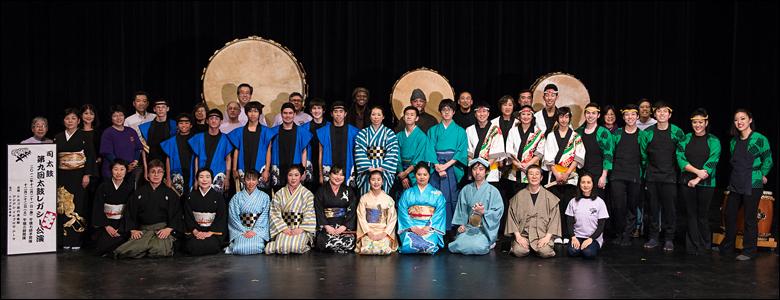Review: Gintenkai – Tsukasa Taiko Drumming
April 11, 2013
The beat and rhythm of a drum is a viscerally powerful motivator and one of the oldest forms of communication. Drum beats historically incited soldiers to fight, inspired athletes to push themselves to the very limits of their physical abilities and still guides celebrants to dance.
Gintenkai, an independent album produced by the Chicago-based Tsukasa Taiko drum group offers a taste of history and adrenaline in the 11 tracks contained within. Named after and performing several of the percussive pieces of the 1970s Tokyo-based performing group Gintenkai, the album is a compilation of more traditional taiko drumming pieces and Tsukasa’s own original modern works. Amy Homma leads the Tsukasa Taiko group and combines traditional Asian percussion with theatrical elements and dress, and breathtaking physical and vocal synchronicity. Tsukasa Taikowas founded in 1996 to “preserve and pass on the traditional concepts of Taiko as a cultural legacy and to utilize these concepts in expanding and evolving the Taiko form.”
The drumming really gets into the listener’s head. The booms of the large skinned drums are punctuated by the crisp clicks of the wooden Taiko sticks used to play them alternatively impacting on the metal side studs. Accentuating the rhythm of the drums are exciting chants and the ring of a metal percussion instrument known as a kane bell. Accompanying Tsukasa on several tracks is a haunting bamboo woodwind instrument known as a shakuhachi flute, played by Kizan Kawamura, and culturally Japanese string instruments called narimono and shamisen played by Tatsu Aoki, Ayutsubo Aoki, and Noriko Sugiyama.
The shape and sound of Taiko drums have roots in China and Korea. The first examples of music using Taiko to surface in Japan was called Gagaku, performed in royal courts around 500 BCE – 300 CE. The Taiko drums were played singly, and often accompanied by string instruments and bamboo flutes as they are in Gintenkai.
Modern Japanese Taiko originated in the post-war Showa era around 1951 as a derivative of Gagaku. Jazz drummer Daihachi Oguchi is credited with creating one of the first multi-drum Taiko groups and splitting the fairly complicated older percussive pieces into several overlapping complementary sub-patterns. This allowed the overall percussion piece to be created by multiple Taiko drummers and for less experienced drummers start with less complicated patterns, further raising the inclusiveness.
Another pioneer in modern Taiko was Sukeroku Daiko, founding the Yushima Tenjin shrine’s Sukeroku Daiko Taiko group. This group was credited for popularizing the eye-catching speedy synchronized choreography and pageantry of large scale Taiko performances. The flowing elegant movements, dizzying speed and multi-directional staccato percussion techniques persist even today during festivals such as Fukuoka Japan’s annual Hakata Dontaku Citizen Festival. Today, Taiko is seen and heard during all manner of celebration in Japan, from large city-wide festivals to school sporting events. There is even a popular arcade videogame based on Taiko drumming named Taiko no Tatsujin or Taiko Drum Master that has won acclaim around the world for its recreation and popularization of the cultural event of playing a Taiko drum.
Many East Asian movies utilize fast-paced, deep-toned Taiko percussion during battle scenes to bring an element of drama and turmoil and capture the viewer’s attention. The deep tones and fast-paced progression of a Taiko group’s overlaid percussion work is attention-grabbing and fascinating to listen to. Tsukasa’s Taiko drumming on their album Gintenkai is no exception to this, and a listener may find their heart begin to beat faster and the urge to stand up and move irresistible. The Gintenkai album is available on amazon.com. For more information on seeing a live Taiko music event or taking a class in Tsukasa Taiko personally, contact Joanne Tohei (joanne@airmw.org) or Noriko Sugiyama (noriko@airmw.org). Tsukasa Taiko also has a frequently updated facebook page at facebook.com/taikolegacy.








